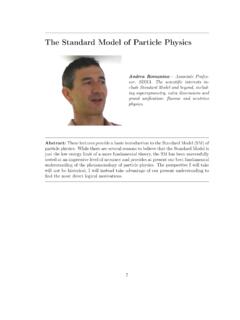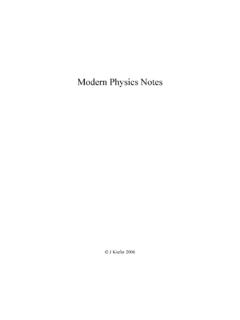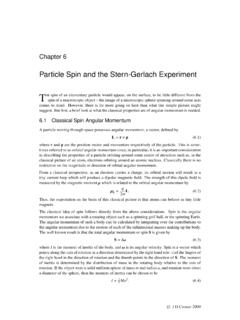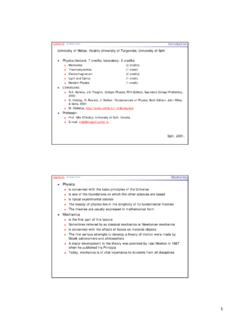Transcription of Particle Physics - Lecture Notes
1 Oxana Smirnova Particle Physics Department2001 Spring SemesterLund University Particle Physicsexperimental insighte+e- W+W- qqOxana SmirnovaLund University2 Basic conceptsParticle PhysicsI. Basic concepts Particle Physics studies the elementary building blocks of matter and interactions between them. Matter consists of particles and fields. particles interact via forces caused by fields. Forces are being carried by specific particles , called gauge [ gejdz] of nature:1) gravitational2) weak3) electromagnetic4) strongBasic conceptsParticle PhysicsOxana SmirnovaLund University 3 Forces of natureNameActs on:CarrierRangeStrengthStable systemsInduced reactionGravityall particlesgravitonlong Solar system Object fallingWeak forcefermionsbosons W and Z< mNone-decayElectromagnetismparticles with electric chargephotonlongAtoms, stonesChemical reactionsStrong forcequarks and gluonsgluonsmHadrons, nucleiNuclear reactionsF1r2 1039 1017 105 F1r2 1137 1015 1 Oxana SmirnovaLund University4 Basic conceptsParticle PhysicsThe Standard Model Electromagnetic and weak forces can be described by a single theory the Electroweak Theory was developed in 1960s (Glashow, Weinberg, Salam).
2 Theory of strong interactions appeared in 1970s: Quantum Chromodynamics (QCD). The Standard Model (SM) combines postulates of SM:1) Basic constituents of matter are quarks and leptons (spin 1/2).2) They interact by means of gauge bosons (spin 1).3) Quarks and leptons are subdivided into 3 SmirnovaLund University5 Basic conceptsParticle PhysicsSM does not explain neither appearance of the mass nor the reason for existence of 3 1: The Standard Model ChartOxana SmirnovaLund University6 Basic conceptsParticle PhysicsFigure 2: History of the UniverseOxana SmirnovaLund University7 Basic conceptsParticle PhysicsUnits and dimensions The energy is measured in electron-volts: 1 eV 10-19 J1 keV = 103 eV; 1 MeV = 106 eV; 1 GeV = 109 eVThe Planck constant (reduced) is then: h / 2 = 10-22 Mev sand the conversion constant is:c = 10-15 MeV m For simplicity, the natural units are used: = 1 and c = 1so that the unit of mass is eV/c2, and the unit of momentum is eV/ch_h_h_Oxana SmirnovaLund University8 Basic conceptsParticle PhysicsAntiparticles particles are described by a wavefunction:(1) is the coordinate vector, - momentum vector, Eand t are energy and relativistic particles , E2=p2+m2, and theShr dinger equation (2) is replaced by theKlein-Gordon equation (3).
3 (2) (3) xt,()Nei px Et ()=xpit xt,()12m------- xt,() 2 =t22 xt,() 2m2 xt,()+ =Oxana SmirnovaLund University9 Basic conceptsParticle Physics There exist negative energy solutions!The problem with the Klein-Gordon equation: it issecond order in derivatives. In 1928, Dirac found thefirst-order form having the same solutions:(4)where i and are 4 4 matrices and arefour-component wavefunctions: spinors (for particleswith spin 1/2). xt,()N e i p xE+t+()=i t--------i i xi-------- m +i = xt,() 1xt,() 2xt,() 3xt,() 4xt,()=Oxana SmirnovaLund University10 Basic conceptsParticle PhysicsDirac-Pauli representation of matrices i and : , Here I is 2 2 unit matrix and i are Pauli matrices:, , Also possible is Weyl representation:, i0 i i0 = I00I = 10110 = 20i i0 = 31001 = i i 00 i = 0II0 =Oxana SmirnovaLund University11 Basic conceptsParticle PhysicsDirac s picture of vacuumThe hole created by the appearance of the electronwith a positive energy is interpreted as the presenceof electron s antiparticle with the opposite charge.
4 Every charged Particle has the antiparticle of the same mass and opposite 3: Fermions in Dirac s SmirnovaLund University12 Basic conceptsParticle PhysicsDiscovery of the positron1933, , Univ. of California (Berkeley):observed with the Wilson cloud chamber 15 tracks in cosmic rays:Figure 4: Photo of the track in the Wilson chamberpositrontracklead plateOxana SmirnovaLund University13 Basic conceptsParticle PhysicsFeynman diagramsIn 1940s, developed a diagramtechnique for representing processes in assumptions and requirements: Time runs from left to right Arrow directed towards the right indicates a Particle , and otherwise - antiparticle At every vertex, momentum, angular momentum and charge are conserved (but not energy) particles are usually denoted with solid lines, and gauge bosons - with helices or dashed linesFigure 5.
5 A Feynman diagram exampleOxana SmirnovaLund University14 Basic conceptsParticle PhysicsVirtual processes:a) e- e- + b) + e- e-c) e+ e+ + d) + e+ e+e) e+ + e- f) e+ + e-g) vacuum e+ + e- + h) e+ + e- + vacuumFigure 6: Feynman diagrams for basic processes involving electron, positron and photonOxana SmirnovaLund University15 Basic conceptsParticle PhysicsReal processes A real process demands energy conservation, hence is a combination of virtual processes. Any real process receives contributions from all possible virtual processes. (a)(b)Figure 7: Electron-electron scattering, single photon exchangeFigure 8: Two-photon exchange contributionOxana SmirnovaLund University16 Basic conceptsParticle Physics Number of vertices in a diagram is called its order.
6 Each vertex has an associated probability proportional to a coupling constant, usually denoted as . In discussed processes this constant is For the real processes, a diagram of order n gives a contribution to probability of order sufficiently small , high order contributionsto many real processes can be neglected, allowingrather precise calculations of probability amplitudesof physical processes. eme24 0------------1137--------- =Oxana SmirnovaLund University17 Basic conceptsParticle PhysicsDiagrams which differ only by time-ordering areusually implied by drawing only one of themThis kind of process implies 3!=6 different timeorderings(a)(b)Figure 9: Lowest order contributions to e+e- Figure 10: Lowest order of the processe+e- Oxana SmirnovaLund University18 Basic conceptsParticle Physics Only from the order of diagrams one can estimate the ratio of appearance rates of processes:This ratio can be measured experimentally.
7 Itappears to be R = 10-3, which is smaller than em, but the equation above is only a first nucleus, the coupling is proportional to Z2 ,hence the rate of this process is of order Z2 3 Figure 11: Diagrams are not related by time orderingRRate e+e- ()Rate e+e- ()-------------------------------------- ------ O ()=Oxana SmirnovaLund University19 Basic conceptsParticle PhysicsExchange of a massive bosonIn the rest frame of Particle A: where , , , From this one can estimate the maximum distanceover which X can propagate before being absorbed:, and this energy violationcan exist only for a period of time t / E, hencethe range of the interaction isr R / MX cFigure 12: Exchange of a massive Particle XAE0p0,()AEAp,()XExp ,()+ E0MA=p0000,,()=EAp2MA2+=EXp2MX2+= EEXEAMAMX +=h_h_Oxana SmirnovaLund University20 Basic conceptsParticle Physics For a massless exchanged Particle , the interaction has an infinite range ( , electromagnetic) In case of a very heavy exchanged Particle ( , a W boson in weak interaction), the interaction can be approximated by a zero-range, or point interaction:RW = /MW = /( GeV/c2) 2 10-18 mConsidering Particle X as an electrostatic potentialV(r), the Klein-Gordon equation (3) for it will look like(5)Figure 13.
8 Point interaction as a result of Mx h_h_Vr() 21r2----- r -------r2 V r ------- M=X2Vr()=Oxana SmirnovaLund University21 Basic conceptsParticle PhysicsYukawa potential (1935)Integration of the equation (5) gives the solution of(6)Here g is an integration constant, and it is interpretedas the coupling strength for Particle X to the particlesA and B. In Yukawa theory, g is analogous to the electric charge in QED, and the analogue of em is X characterizes the strength of the interaction at distances r a Particle being scattered by the potential(6), thus receiving a momentum transfer Potential (6) has the corresponding amplitude, Vr()g24 r---------erR = Xg24 ------=qOxana SmirnovaLund University22 Basic conceptsParticle Physicswhich is its Fourier-transform (like in optics):(7)Using polar coordinates, , andassuming , the amplitude is(8) For the point interaction, ,hence becomes a constant.
9 That means that the point interaction is characterized not only by X, but by MX as ()Vx()eiqxd3x =d3xr2 d drd sin=Vx()Vr()=fq()4 gVr()qr()sinqr------------------r2rd0 g 2q2MX2+--------------------==MX2q2 fq()fq()G 4 XMX2-----------------==Oxana SmirnovaLund University23 Leptons, quarks and hadronsParticle PhysicsII. Leptons, quarks and hadrons Leptons are spin-1/2 fermions, not subject to strong interaction Electron e-, muon - and tauon - have corresponding neutrinos e, and . Electron, muon and tauon have electric charge of -e. Neutrinos are neutral. Neutrinos possibly have zero masses. For neutrinos, only weak interactions have been observed so far ee- , - , - Me < M < M Oxana SmirnovaLund University24 Leptons, quarks and hadronsParticle Physics Antileptons are positron e+, positive muon and tauon (pronounced mju-plus and tau-plus), and antineutrinos: Neutrinos and antineutrinos differ by the lepton number.
10 Leptons posses lepton numbers L =1 ( stands for e, or ), and antileptons have L =-1. Lepton numbers are conserved in any interactionNeutrinos can not be registered by any detector, there are only indirect indications of their quantities. First indication of neutrino existence came from -decays of a nucleus N:N(Z,A) N(Z+1,A) + e- + ee+ e , + , + Oxana SmirnovaLund University25 Leptons, quarks and hadronsParticle Physics -decay is nothing but a neutron decay: n p + e- + e Necessity of a neutrino existence comes from the apparent energy and angular momentum non-conservation in observed reactions Note that for the sake of the lepton number conservation, electron must be accompanied by an antineutrino and not neutrino!Mass limit for e can be estimated from the precisemeasurements of the -decay:me Ee MN - m eThe best results are obtained from the tritium decay:3H 3He + e- + eIt gives m e 15 eV/c2, which usually is consideredas a zero SmirnovaLund University26 Leptons, quarks and hadronsParticle Physics An inverse -decay also takes place: e + n e- + p(9)or e + p e+ + n(10)However, the probability of these processes is verylow, therefore to register it one needs a very intenseflux of neutrinosReines and Cowan experiment (1956) Using antineutrinos produced in a nuclear reactor, it is possible to obtain around 2 events (10) per hour.






